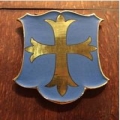House System
At the start of this article it is worth noting that from 1890-1902 Bishop’s was a boys-only school; girls were admitted for the first time in 1902, and they grew in number until 1927 when South Wilts Girls’ Grammar was founded at Stratford Road in Salisbury. BWS then reverted to boys only until September 2020 when our Sixth Form will once again become Co-Educational





The school was started in the Bishop’s Palace, moving to the Chapel Block Building on Exeter Street when this was completed later in 1890. The school also acquired the use of accommodation for boarding houses at both Exeter Street and Grosvenor Terrace. When the Bishopgate Building was completed in Easter 1904 this was used for both the Headmaster’s House and as a boarding house. In September 1904 a large house in the Friary was acquired as a girls’ boarding house and the use of this building by the school continued until the girls departed for their new school.
The only reliable early records of the school’s life are the accounts of Reuben Bracher’s speeches from Prize Giving; these are recorded as summaries from 1890-1927, but in them no mention is made at any point of a House System. The first copy of the Wordsworthian in the archives dates from 1915, and this gives a fuller picture of life at Bishop’s. At this time there were Junior and Senior Preparatory Departments, with the Senior School then being divided into a, b & c divisions, some of which were single sex and some mixed. In 1916 mention is made of a ‘g’ form in each year (girls only), and then from 1919 an ‘m’ (matriculation) division is introduced. These form designations appear to have been purely for administrative convenience rather than generating a strong sense of identity amongst the pupils.
From 1925 new prefect and house systems were introduced for the girls, firstly to operate in the New Street Building and then extended to the rest of the school. The intention is explicitly given in the magazine – the girls (and one presumes the boys too) wanted more unity and identity, which were otherwise difficult to build given the scattered nature of the school’s estate. The four divisions (or houses) were given colours – Red, Green, Blue and Yellow, with two further colours (Purple and Brown) being added in 1926. At Sports Day in 1926 it is clear that there was healthy rivalry between the six houses, involving both boys’ and girls’ athletics.
With the arrival of Headmaster Happold in 1928, six new Houses were founded with each named after a Bishop, as follows:
- Bishop Dunstan (909-988) of Glastonbury was one of the first ecclesiastical statesmen in England, becoming Archbishop of Canterbury in due course;
- Bishop Trelawny (1650-1721) of Bristol stood up against church reforms proposed by James II and was imprisoned in the Tower, but was later acquitted;
- Cardinal Wolsey (1473-1530) became Archbishop of Canterbury under Henry VIII – but fell foul of the King’s wrath when he failed to secure the Pope’s approval for Henry’s divorce from Catherine of Aragorn;
- Bishop Ridley (c1500-1555) took a leading role in the protestant reforms that took place under Edward VI, and later became a protestant martyr – he was burned at the stake during the reign of Mary I;
- Becket (1118-1170) became Archbishop of Canterbury under the patronage of Henry II, but was later murdered in Canterbury Cathedral, possibly at the orders of the king. The two had profoundly disagreed on the balance of power between Monarch, State and Church. Becket was canonised as a saint;
- Bishop Berkeley (1685-1753) was an Irish cleric and philosopher. He became a missionary in North America, later returning to Ireland to work and write.
These new houses were popular but also fairly short lived. In the 1935-36 Annual Record it states the following…
“Cries of “Becket”, “Dunstan” and other Episcopal slogans, familiar to past members of the School are now heard no more on the playing fields. It was found that six ‘houses’ were too many for a school of this size if there were to be a sufficient variety of games to suit all tastes and abilities and keen boys were not to be overtaxed. It was decided to reduce the number to four. Much discussion took place as to how they should be named. It was finally decided to keep the episcopal tradition and to call them after four Bishops of Salisbury, Osmund, Poore, Martival and Jewell”.
In September 2017 a fifth house was introduced as the lower school intake increased to 160 students per year. The new house has been named Ward in honour of Seth Ward, Bishop of Salisbury between 1667 and 1671





